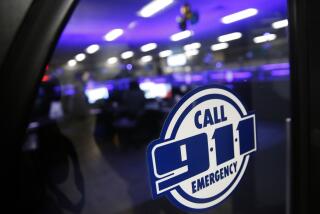Column: ‘Unusually high call volume’? You’re being lied to, say experts
Call a business, any business. Chances are, you’ll hear a recording that says they’re experiencing “unusually high call volume” so you should expect a long wait on hold.
You’re being lied to, experts say.
Call volume in fact is about the same as it was prior to the COVID-19 pandemic, call center industry insiders and academics who study the business tell me.
What’s different now is that, because of the coronavirus, there are far fewer people answering phones.
“It’s really a problem,” said Mark Rollag, president of xtDirect, an Omaha call center company with operations worldwide. “Most companies just weren’t prepared for something like this.”
He told me that, roughly speaking, there are about 25% fewer call center agents answering phones than before the pandemic because of cutbacks and a lack of resources for agents to work from home.
And that’s here in the United States. Overseas, in call-center-heavy countries such as India and the Philippines, entire facilities were shut down because of COVID-19 risk. Some have reopened. Many have not.
This means thousands of calls daily are being handled abroad by relatively few English-speaking agents equipped with the gear to work remotely.
“Call volume is not up,” said Maddy Martin, head of growth and education for Smith.ai, a Palo Alto outsourcing firm that provides clients with “virtual receptionists.”
Her company’s average client has “the same number of calls per week as it did late last year,” she said.
Aaron Sackett, an associate professor of marketing at the University of St. Thomas, said many if not most companies have adopted “unusually high call volume” as their default explanation for long waits on hold.
He said this excuse is given “whether the reason for it is a surprising number of callers, a surprising number of bathroom breaks at the customer call center, or that the company decided to cut costs by reducing the number of call center employees.”
Thomas Robbins, an associate professor of marketing and supply-chain management at East Carolina University, said the growth of “unusually high call volume” recordings is due in part to businesses trying to manage customer expectations during the pandemic.
“If they tell you five minutes and answer in four, you are much happier than if they tell you two minutes and answer in three,” Robbins observed.
He also said the call volume recordings may be intended to prod more people into going online, where companies can more easily (and cheaply) handle customer problems.
“They are very motivated to get your issue resolved without having to talk to you,” Robbins said.
Nothing new there. Businesses have been laser-focused for a long time on keeping customers at arm’s length.
Human service reps are expensive. Automated systems are much, much more penny-wise.
A 2017 study by IBM found that businesses spend more than $1 trillion a year on customer service calls. A call handled by a human agent can cost a company $15 to $200, IBM found. With an automated system, that cost drops to just $1.
The catch: Consumers consistently say that if they have a matter to resolve, they don’t want to deal with a robot. They want a living, breathing person.
A survey last year found that 86% of consumers prefer interacting with a human agent rather than an automated system.
Moreover, 71% of respondents said they’d be less likely to stick with a brand “if they knew that brand didn’t have human agents available.”
Businesses that think they can pull a fast one on customers with automation, therefore, are only fooling themselves. They’re ignoring people’s preference solely to save themselves a few bucks.
And this has been going on for decades.
The year 1973 saw a ceasefire declared in Vietnam. Richard Nixon was sworn in for a second term as president. Pink Floyd released “Dark Side of the Moon.”
It was also the year the automated switchboard was born.
The underlying technology of this most satanic of devices was invented in the workshop of an Iowa company called Collins Radio, which nearly half a century ago created the digital voice switch, allowing electronic routing of voice data.
This breakthrough would serve as the foundation of a variety of other technologies that, combined, would make the modern phone tree possible.
Press 1 for this, press 2 for that. Abandon hope all ye who enter here.
Personally, I’d be fine with companies admitting in their recordings that they need to economize because of the pandemic, so please be patient. But that’s not what they’re saying.
Instead they’re hiding behind the fiction of unusually high call volume to mask their unwillingness to meet customer demand for service. They’ve chosen dishonesty as a corporate strategy.
Anthony Dukes, a marketing professor at USC, said the question at this point “is how incentivized are some companies to rectify that problem.”
“Some companies may not feel it is worth it to be extra customer-driven at the moment,” he said.
Sackett at St. Thomas University observed that, from a customer psychology perspective, offering any explanation for a long wait on hold is better than nothing.
“Psychological research on persuasion shows that a ‘because’ statement, even if meaningless, can make a big difference in how people react to a request,” he told me.
“People don’t really think about the explanation. Their minds just process that there is one.”
Sackett added, though, that claiming an unusually high call volume “is pretty feeble when consumers are used to hearing it no matter when they call. Plus, after hearing it, they typically have many minutes to sit and stew in their skepticism about whether the statement is really true.”
I have a couple of suggestions.
First, pass a temporary tax break for companies that invest in sufficient levels of support staff. Millions are out of work. Let’s reward companies that hire and train people to work from home during the pandemic and possibly beyond.
Second, some lawmaker should draft a Stuck on Hold Truth Act. That is, it should be illegal to deceive consumers about why they’re languishing on hold or their prospects for getting through to a person.
I’m not saying automated switchboards should be done away with, despite their overwhelming unpopularity among consumers. There are probably some people who find them convenient.
I’m saying it should be illegal to tell consumers that they’re the problem when the problem is actually a skinflint company.
Here’s another idea for companies during these challenging times: Improve your product or service so it doesn’t prompt customer calls.
At the very least, have the courage to play a recording that says, “You’re going to be on hold for a long time because we don’t employ enough people to handle our call volume.”
Honesty is still the best policy.
More to Read
Inside the business of entertainment
The Wide Shot brings you news, analysis and insights on everything from streaming wars to production — and what it all means for the future.
You may occasionally receive promotional content from the Los Angeles Times.











